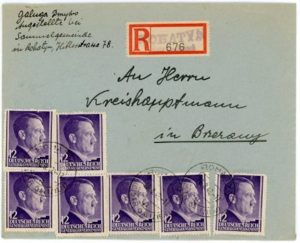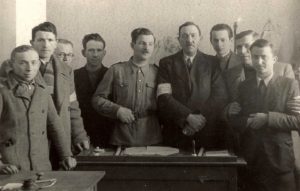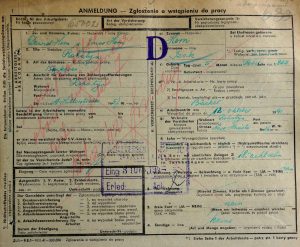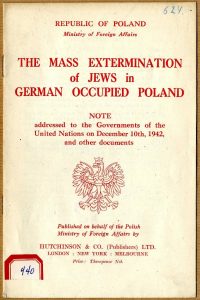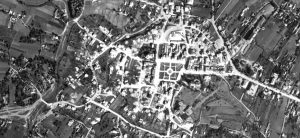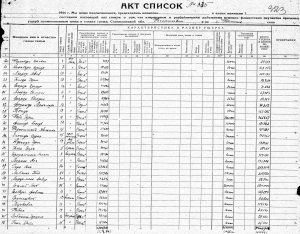![]() Ця сторінка також доступна українською.
Ця сторінка також доступна українською.
Go to the outline, A History of the Jewish Community of Rohatyn.
The following timeline is based on an outline history of Rohatyn’s Jewish community during World War II and the Shoah (also known as the Holocaust), assembled by Alex Feller for the Rohatyn District Research Group (RDRG). For a thematic perspective on some of these events, you can browse a selection of related articles we have assembled on History and Culture.
Because of the near-complete destruction of Rohatyn’s 350-year Jewish community by the German military and their accomplices during the war, and the near-complete erasure of Jewish identity in the region by Soviet policies after the war, records and images of specific wartime events and people in Rohatyn are scarce. For this timeline and related thematic articles, we reference a variety of sources including several versions of the Rohatyn Yizkor (memory) book, testimonies and oral interviews (Jewish and Ukrainian), written memoirs of and personal correspondence with survivors of the Rohatyn ghetto, as well as general histories of the region and the period. These sources are listed at the end of this page. We welcome information about historical resources not listed here, including histories and memoirs from Ukrainian, Polish, Jewish, and other sources.
History can sometimes seem cold and distant, but for survivors of the Shoah in Rohatyn, the terror and anguish has remained very present in memory and daily life. The personal experience of one survivor, Jack “Kuba” Glotzer, is interleaved in this timeline in italics, to better explain how events in the region and in the town affected the Jews of Rohatyn; Jack’s full memoir is horrifying even decades after the events. Throughout the timeline, we have also linked to the personal recollections of nine elderly Ukrainians who lived through the war in Rohatyn and nearby villages, from video interviews conducted by Yahad – In Unum in 2016; their memories of adolescence and young adulthood during the Soviet and German occupations illuminate not only specific events in Rohatyn but also the relationships between Ukrainians, Poles, and Jews before and during the war, as neighbors, classmates, strangers, and friends.
Note: Place names are written here in their Polish spellings; when the war began, Rohatyn was part of the Second Polish Republic.
Timeline
1939 Sep 01 – After “reunifying” Austria with the German Third Reich, and occupying Czechoslovakia in 1938 and 1939, Germany invades Poland; two days later, France, Great Britain, and much of the British Commonwealth declare war on Germany, opening World War II. Refugees from western Poland flee to Rohatyn and other eastern Polish towns. [2]
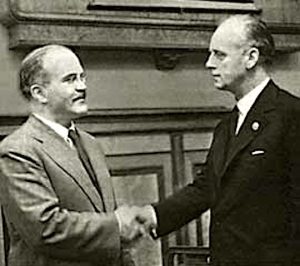
Molotov and Ribbentrop at the signing of the Pact.
1939 Sep 17~18 – The Soviet Army occupies Rohatyn, claiming eastern Galicia as part of Soviet Ukraine under a secret pre-war Soviet-German agreement known as the Molotov–Ribbentrop Pact. Under Soviet rule, Jewish communal and political activities cease; private commerce is reduced. [2]
1939 Sep 28 – Warsaw surrenders to the Germans. A “Phoney War” begins, in which there are no major military operations on the Western Front for almost eight months.
1940 Jan 12 – Kuba Glotzer turns 15. He lives in a large house built by his grandfather Kalmen Glotzer, located between Rohatyn’s town square and the river Gniła Lipa, together with his mother and two younger brothers, his father’s brother’s family, and with the Altman family (his father’s sister, her husband, and Kuba’s cousins). Kuba’s father is in America, trying to get visas to bring his family with him, but the war is blocking most travel options. Kuba has completed 7 years at Rohatyn’s Polish “Red School”, and now works for his father’s brother in a butcher shop. There are about 3000 other Jews resident in Rohatyn, plus refugees. [4, p.5~9]
1940 – Soviet trade cooperatives are formed in Rohatyn, mostly managed by Jews.[2]
1940 Spring – Under Communist rule in Rohatyn, wealthy Jewish families and politicians are arrested, tried, and deported, including the Grad family, textile merchants in town. [2] [3, p.299] [4, p.9] Many refugees in Rohatyn register to return to German occupied hometowns due to lack of housing and jobs, but are deported east instead. [2]
1941 Jun 22 – The German Army terminates the Molotov–Ribbentrop Pact by attacking the Soviet Army in Poland under Operation Barbarossa. [15, p.263] Soon after, the Soviet Army withdraws from Rohatyn, leaving ammunition at the train station. [4, p.10] Several days of bombing at Chodorów and other nearby areas mark the imminent arrival of the German army, which passes through on its way east. For a few days, there is neither Soviet nor German presence in Rohatyn, Ukrainian flags flew on the town hall, and for some, life briefly became nearly normal. [12, witness YIU/2102U, 19:45~24:49]
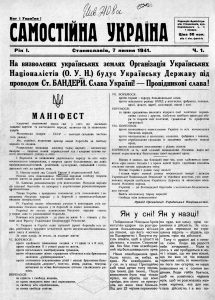
The front page of the new “Independent Ukraine” newspaper, published a week after the OUN declared independence for Ukraine.
1941 Jun 30 – Following the withdrawal of Soviet forces from the region, the Organization of Ukrainian Nationalists under Stepan Bandera (OUN-B) declares an independent Ukrainian State in Lviv. In the declaration, the new government acknowledges the aid of the German Nazi government in its effort to free the Ukrainian people from Soviet occupation. The German government is surprised by the declaration, and orders the new Ukrainian government to disband. [8, p.671]
1941 Jul 02 – The German Army enters Rohatyn. [3, p.287] [2] Rohatyn becomes part of Germany’s General Government, under the leadership of Hans Frank.
1941 Jul 03 – A Ukrainian People’s Militia is formed in Rohatyn; later in the year this becomes the Ukrainian Auxiliary Police. At the same time, Jews start to suffer hunger, as they cannot easily buy food. [3, p.287]
1941 Jul 05 – Stepan Bandera is arrested by the German military and detained in Berlin. [8, p.671] Two of his brothers are arrested as well, and will later die at Auschwitz. [15, p.267] Bandera will remain in captivity until the autumn of 1944.
1941 Jul 06 – The first attack by the Ukrainian militia. Jews are forced to lie down in the market square and are beaten with iron poles. [3, p.287] [2]
1941 Jul 07 – The first issue of “Independent Ukraine”, published in Stanislaviv (Stanisławów), features a manifesto on the first of its four pages, announcing the new Ukrainian state under the leadership of Stepan Bandera. Paragraph VI of the manifesto declares “a struggle for the dignity and freedom of man, for the right to recognize clearly his convictions, and for the freedom of all confessions.”
1941 Jul 12 – The Gestapo lock 500 male Jews in a synagogue and threaten to burn it down. [3, p.287] [2] [4, p.10]
1941 Jul 23 – A local Rohatyn newspaper in Ukrainian language under German occupation, Рогатинське слово (Rohatyn Word) begins publication under the editorial command of Mykola Uhryn-Bezhrishniy, a prominent Rohatyn gymnasium teacher, poet, and essayist. The newspaper will continue mostly weekly for four months. The cover of the first issue prints the entire text from an OUN-M leaflet dated 05 July and addressed to the Ukrainian people; it traces the unbroken focus on national unity by strong past leaders, marking the negative past influence of foreigners, and castigating “the red butcher of Ukraine: Moscow”. Toward the end of the stirring call, the author writes “Down with the Communists and their assassins. Death to their Jewish henchmen, the Communist-Bolsheviks.” and “Be alert to the provocateurs of the Jewish-Bolshevik gang trying to get in the way of the state-building work of the Ukrainian nation.” Included in the closing salutations are the slogans “Glory to the invincible regiments of the German Army!” and “Long Live the Führer Adolf Hitler!” [7, Vol. 1, p. 1] [24, p.506] [25, p.150-151] On page 3, it is reported that the Rohatyn City Council has voted to change the names of thirty streets in town. Most had been Soviet/Communist or Polish names, and are now renamed for Ukrainian folk, arts, military, and historical figures (for example, Rosa Luxemburg Street is changed to Olha Kobylianska Street). However, a portion of the former Red Army Street, including where the editorial office of “Rohatyn Word” is located, is newly named Adolph Hitlerstrasse. [7, Vol. 1, p. 3] And on page 4, an advertisement by the Rohatyn city higher education department offers new German language courses for its employees and other citizens at beginning and advanced levels. [7, Vol. 1, p.4]
1941 Aug 01 – Rohatyn becomes a regional city within Distrikt Galizien of the General Government, under control of German district chief Hans-Adolf Asbach. [7, Vol. 5, p. 2] A “Jewish residential district” (open ghetto) in Rohatyn is established, earlier than most other towns in the district; all Jews living outside the ghetto are forced to move into it. Refugees from western Poland are forced to leave immediately. The Judenrat (Jewish council), Jewish police, and Jewish labor board are formed. Jews are required to wear yellow armbands with the Star of David. The Jewish police have no special uniform but wear a kepi-style cap with a Star of David; they carry batons, but no guns. [12, witness YIU/2102U, 33:01] Some Judenrat members wear a round red insignia on their chest to avoid being killed with other Jews. [12, witness YIU/2095U, 32:25] A “penalty” of 1 million złoty is imposed. [2] [3, p.307] All food entering the ghetto is passed through the Judenrat, and limited by German authorities; hunger and starvation persist for the remainder of the German occupation. [3, p.287][4, p.10~11]
1941 summer – The German administration in Rohatyn dismisses local government leaders who are known to be Ukrainian nationalists, and forbids assembly of Ukrainian nationalist organizations, flying national flags, and expressing nationalist sympathies. A new tax is levied on common products, payable to German authorities; failure to pay is punishable by death. [12, witness YIU/2102U, 01:37:40]
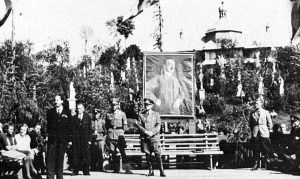
Asbach in uniform in front of a portrait of Adolf Hitler, at a harvest festival in Brzeżany in 1942. Source: Landesarchiv Schleswig.
1941 Oct 04 – The “Rohatyn Word” newspaper reports a decree from the German Governor-General requiring a labor obligation for all men of Galicia aged 18~60, with a separate labor order for Jews. A police order is also reported requiring all Jews to wear a yellow star of David in public. Elsewhere in the same edition, the paper provides a language aid with the transliteration and translation of the German word gelb, “yellow”. [7, Vol. 13, p. 4]
1941 Oct 12 – Sixteen-year-old Izak “Izio” Horn is given a labor card by the Nazi authorities to exit the ghetto daily for forced labor at a bakery formerly owned by his father Jonas and his uncle David. [21] The bakery had been taken by the Germans in August, its bread production used to supply the Judenrat for consumption in the ghetto. Izio is supposed to be paid, but only 18 złoty per week. Compulsory work and supplemental rations will help Izio endure the harsh ghetto conditions, but he will not survive the war.1941 Oct – Jews living in villages outside of Rohatyn are ordered to move to the Rohatyn ghetto, but some are initially unsure whether they should go. The only Jewish family in Perenówka is frightened when someone in the village throws a hand grenade into their house. The grenade is not functional, but the family takes the advice of a Ukrainian friend who lives next door, and moves to the Rohatyn ghetto for safety. [12, witness YIU/2102U, 01:29:23]
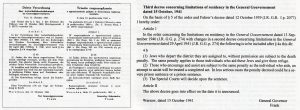
Death penalty for Jews who escape the ghetto, and for those who help them, 15Oct1941. Source: Muzeum Historii Polski.
1941 Oct 15 – General Governor Hans Frank issues a third decree concerning residency in the General Government: Jews who depart the the district they are assigned to, without permission, are subject to the death penalty [5]. Impairing the ability of Jews to get help from Poles and Ukrainians in the region, the same death penalty is imposed on any individuals who give Jews aid or refuge; even encouraging others to aid is penalized with a severe prison sentence or death.
1941 Nov 01 – The “Rohatyn Word” newspaper reports that the Jewish Agency in Jerusalem is calling for a recruitment of Jews to support England; the Agency is quoted: “in this critical period, the Jews, who are still not generally engaged in the war, should take up arms.” The news includes a description of a military parade in Tel Aviv to support the recruitment. [7, Vol. 17, p. 4] Elsewhere in the same issue, among news reports selected by the editor for a section titled “In Ukraine”, a post from the “Ukrainian Herald” notes that already “The population of the villages on both banks of the Zbruch River is purely Ukrainian […] In cities, of course, there is a certain percentage of Jews, though today clearly diminished, and in Galicia there is still some impurity from the Poles.” The article goes on to describe the ways Jews were eliminated from the villages, including by being rounded up and marched carrying signs with language such as ‘We were your oppressors’ and ‘We are spies, seeking punishment’. The article concludes, “Today, everywhere in villages and cities, Ukrainian German flags are flown.” [7, Vol. 17, p. 2]
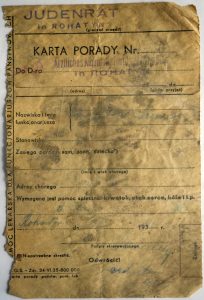
A card used by the Judenrat in Rohatyn, found in the walls of the building in 2011. Source: Rohatyn Opillia Museum.
1941 Nov – Rohatyn becomes a sub-district city under command of Stanisławów within the General Government. [3, p.287]
late 1941 – Jews from Czercze, Potok, Babińce, Zalipie, and Podkamien are moved to the Rohatyn ghetto. [2]
1941 Dec – The Fur Operation: Jews are required to turn over furs under penalty of death. [3, p.288]
1942 Jan 20 – In Germany, Nazi government and SS leaders attend the Wannsee Conference, called by RSHA director Reinhard Heydrich, to develop inter-agency cooperation plans as part of their long-term project of a “Final Solution to the Jewish Question” (Endlösung der Judenfrage). Killings of thousands of Jews had already taken place in Distrikt Galizien following the German occupation, including in Lwów and Stanisławów.
1942 Feb – Jews are taken to dig pits in a field near the Rohatyn train station south of the town center, for a rumored brick factory foundation. At least one pit is huge, “larger than a house” and “deeper than a room”. [2] [12, witness YIU/2096U, 11:19, 15:27, 22:03]
1942 Feb – Andrey Sheptytsky, the Metropolitan Archbishop of the Ukrainian Greek Catholic Church in Lviv, writes a letter to Heinrich Himmler, the German SS Reichsführer, objecting to the German use of Ukrainian auxiliary police in a recent anti-Jewish action in Rohatyn. The letter, now lost, expressed pain at the behavior of German military and police in the mistreatment and execution of regional inhabitants, primarily Jews, and requested that the Ukrainian police (composed exclusively of members of his faith) be excluded from extermination actions against the Jews. In letters to the Pope and others soon after, Sheptytsky highlighted his attempts to prevent Ukrainian youths from joining organizations which could expose their souls to danger, especially the psychological risks of participation in murders. [11, p.344~348]
1942 Mar 19 – Gestapo from Stanisławów arrive in Rohatyn in the evening to supplement the small number of German security police who are stationed in town. [12, witness YIU/2102U, 37:42] [13, p.821]
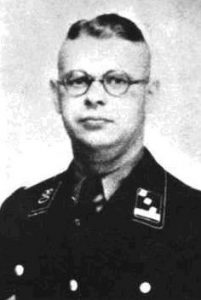
Hans Krüger in uniform. Source: Wikipedia.
1942 Mar 20 – Gestapo men under the leadership of Hans Krüger, together with Ukrainian militia, surround the ghetto and forcibly assemble there and in the town square roughly 3000 Jewish adults and 600 Jewish children, including 1000 refugees. [12, witness YIU/2092U, 01:20:55] The Jews are then taken on foot and by trucks to the pits a short distance beyond the Rohatyn train station, where they are systematically murdered in a single day by rifle fire, in small groups lined up and facing the pits, shot from behind. [3, p.288] [10] [12, witness YIU/2092U, 01:21:18; see also witness YIU/2096U, 23:05] Ukrainian school children pass by the ghetto after the round-up and see dead victims on the ground; German soldiers chase the children away. [12, witness YIU/2095U, 18:56] The shooting at the pits outside of town is audible in Rohatyn schools, and it is known what is happening; some teachers teachers tell their pupils that the Jews are being shot, but most forbid discussion of the event. [12, witness YIU/2092U, 01:34:00; see also witness YIU/2095U, 45:55] Kuba Glotzer survives the aktion by hiding in a closet in a neighbor’s house; his mother and brothers survive in the Glotzer house by hiding in an attic, the entrance to which was covered by a wardrobe. Only 100~110 Jewish families survive the aktion. [4, p.12~13]
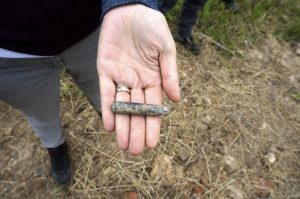
The shell of a rifle bullet found at the mass grave site in 2017. Source: RJH.
1942 Mar 21~23 – Kuba and about a dozen other surviving young Rohatyn Jews are forcibly recruited to collect corpses in the ghetto and in town, untangle frozen bodies at the pre-dug pits where most of the killing took place, bury the dead, and cover the corpses with earth at the mass grave. The gruesome process takes several days. [4, p.14]
1942 Apr 01 – Distrikt Galizien is reorganized, with new boundaries for regional Kreise; German Security Police control of Rohatyn transfers from the center in Stanisławów to the one in Tarnopol. [13, p.744]
1942 May 01 – A new Judenrat is formed to replace the murdered members. The ghetto perimeter is reduced, concentrating the surviving Rohatyn Jews and new arrivals from Knihynicze. Poor living conditions cause a typhus epidemic in the ghetto. [3, p.288]
1942 spring – Starvation is widespread in the ghetto; some Jews risk their lives to pass back and forth through the ghetto perimeter in search of food, for which they barter valuables and hand-made articles. The German authority orders the establishment of a hospital in the ghetto, but provides no bedding; although many are sick, Jews avoid the hospital for fear of German execution actions. Jewish leaders organize to create a soup kitchen in the ghetto to aid the neediest families, but fear and scarce supplies limit the number of Jews who use the kitchen. [18, p.36~39]
1942 Jun – Leah Barban, Kuba Glotzer’s grandmother and a well-respected midwife in pre-war Rohatyn, succumbs to typhus in the ghetto. Kuba, his brothers, and two cousins carry her body to the Jewish cemetery, dig the grave with a single shovel, and bury her there. [4, p.15]
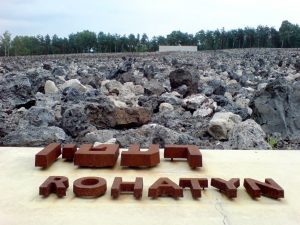
The memorial for Rohatyn Jews killed at the Bełżec extermination camp. Source: Edgar Hauster.
1942 Sep 21 – Yom Kippur is observed in the ghetto. About 800 Jews (300 from Rohatyn and 500 from Knihynicze) are assembled near the Talmud Torah building. 25 Jewish men are shot on the spot; the remainder are transported to the Bełżec extermination camp. [3, p.288] [26, p.233] Kuba Glotzer and his family survive by hiding in the attic of their house and in the cellar of the German police station, where Kuba had previously worked. Kuba witnesses the murders of friends and acquaintances. [4, p.16~17]
1942 Oct – Jews from Bursztyn, Bołszowce, and Bukaczowce are brought into the Rohatyn ghetto. [3, p.289] The ghetto is reduced in size, forcing the Glotzer-Altman family and others to move. [4, p.18]
1942 Nov10 – SS-Obergruppenführer Krüger orders the “Jewish residential district” in Rohatyn completely fenced off, creating an enclosed ghetto. [13, p.822]
1942 Nov – About 30 Jews hiding inside Rohatyn ghetto houses are detected and reported by Ukrainian boys, then rounded up by Germans and marched under armed guard toward the water treatment plant. When the Jews are ordered to turn off of the road, they understand they are meant to be killed, and they scatter in all directions, but the Germans shoot and kill them all. A young Ukrainian shop clerk and his co-worker, who were walking home from work in the same direction by coincidence, also run for fear of the gunfire, but the Germans see they are not with the Jews and spare them. [12, witness YIU/2102U, 55:31]
late 1942 – Several young Jewish women separately escape the Rohatyn ghetto, and disguised as Poles they are taken into forced labor in Germany with other Polish and Ukrainian women; three of the Rohatyn Jews will survive bombings in Stuttgart and reunite there at the war’s end. [18, p.224~229]
1942 Dec 8 – Gestapo from Tarnopol under the leadership of Hermann Müller gather more than 1500 Jews (including 200 sick from the Jewish hospital in the ghetto) and transport them to Bełżec. [3, p.289] [26, p.238] [4, p.18] [9] Kuba Glotzer has contracted typhus in the ghetto and is unconscious for much of the aktion; his family drags him to a hiding place in the attic of a nearby house. His fever breaks and he awakes in the attic; he sees families pulled from the cellar of the same house and taken away, including his aunt Malkah Altman and her daughter Clara. [4, p.18]
1942 Dec 10 – Edward Raczyński, foreign affairs minister of the exiled Polish government in London, signs and delivers a nine-page note to the governments of the signatory countries of the United Nations Declaration and the foreign ministers of other Allied countries. The note, based on documents imported by Jan Karski from the Jewish Affairs Department of the Home Army Headquarters, details evidence of the systematic extermination of Jews by the German government in occupied Poland, and calls on the Allied governments to stop the ongoing crime. [19]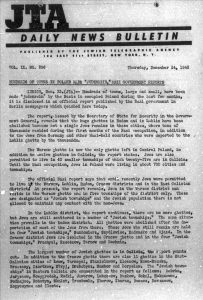
The JTA news bulletin. Source: Jewish Telegraph Agency.
1942 Dec 23 – The German Secretary of State for Security in the General Government issues an official report stating that hundreds of towns in occupied Poland have been made “judenrein” by deportation to 13 ghettos in larger cities and 42 in smaller townships, the majority in Galicia. Rohatyn is named among the east Galician townships in the Nazi report, along with Brzeżany, Stanisławow, Stryj, and Tarnopol; by this time no smaller towns near Rohatyn have Jewish populations except Bobrka and Buczacz. No mention is made of Bełżec or other camps. The report is summarized in the Jewish Telegraph Agency’s daily newsletter and subsequently repeated by other US newspapers. [6] Even in the Rohatyn ghetto, the Glotzers and others hear that the surrounding towns are now empty of Jews. [4, p.19]
1943 Jan – The ghetto perimeter is further reduced and locked, containing 1000 Jews. Survivors prepare hiding places in cellars and attics. [3, p.289]
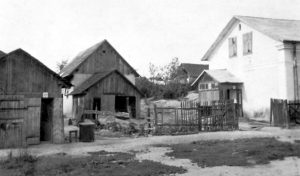
A location in the Rohatyn ghetto where a large Jewish bunker was built.
1943 Apr~May – Having heard details of the recent Warsaw ghetto uprising, Meir Weisbraun (chief of the Jewish Police) organizes and leads an underground Jewish guerilla unit to build a huge bunker in the forests 10km outside Rohatyn, and several large bunkers beneath the houses of the Rohatyn ghetto. The forest bunker is discovered, but defensive hiding places in the ghetto remain. [17, p.103~105]
1943 Jun 6~8 – Liquidation of the Rohatyn ghetto, and an attempt to kill all remaining Jews there. Gestapo and Ukrainians surround the ghetto, set houses on fire, and throw grenades. Much of the ghetto is leveled by fire, leaving only the Judenrat building and a few other Jewish buildings standing. The few thousand Jews who survive the initial round-up are marched in a column on the road north out of the Rohatyn city center, weeping, some carrying small children. [12, witness YIU/2094U, 09:46~14:37]. From the side of the road, a Ukrainian schoolchild sees her Jewish girlfriend in the column, and they yell out to each other, “Farewell!” [12, witness YIU/2095U, 52:46] Many armed men manage the column, which stretches so long that bystanders can barely see the end of it. [12, witness YIU/2098U, 19:01] Throughout that day and for the next two, armed guards encircle the Jews, force them to undress, then shoot them over a large mass grave north of the town center, near the new Jewish cemetery and a monastery. [3, p.290] [12, witness YIU/2100U, 41:00~55:00; see also witness YIU/2102U, 01:13:33] Over the next days, the corpses in the pit are covered with lime and then with earth, but the stench from rotting flesh persists, unbearable to passers-by. [12, YIU/2102U, 01:13:54] There is insufficient space to hide in the house where the Glotzers had been living, so the family ran to a nearby barn where many others were hiding; Kuba and his middle brother Samuel climb into the barn’s attic, while his mother and youngest brother Moshe Emanuel hide in the main part of the barn. The Gestapo and others are searching for the Jews; a Ukrainian man named Melnik, who speaks Yiddish, calls out from the road that the Jews should come out, that the aktion is over. The Jews in the main part of the barn exit, and are shot. Kuba, who has a view out the barn attic window, sees his mother and youngest brother murdered; Toba Glotzer was 45 years old; Moshe Emanuel was 13. Kuba and Samuel remain in hiding for several days without food; when they finally exit, there are corpses everywhere. The Jewish survivors are grief-stricken; some attempt suicide. [4, p.19~20]
1943 Jun 10 – The brothers Kuba and Samuel Glotzer leave the Rohatyn ghetto at night, with their cousins Clara Glotzer and Josie Altman (Malkah Altman’s son), and several other Jews. For the next year, they will be in the forests and villages to the east of Rohatyn, searching for food and shelter, always in danger from the German Army and from locals who might detect and betray them. In their journey, they are also aided by some locals, both Poles and Ukrainians, with shelter, food, information, and advice. But mostly they are alone, and desperate. They move between Puków, Cześniki, Łopuszna, Lipica Górna, and Podwysokie, as rumors and visible threats push them, and hunger and practical needs pull them. [4, p.20~29]
1943, late Jun – To lessen the danger to a Polish family sheltering the Glotzers and other ghetto survivors in Babińce, a suburb at the east side of Rohatyn, the group splits; Kuba’s brother Samuel, his cousin Clara Glotzer, and another Jew stay with the Poles; Kuba and his cousin Josie Altman head into the woods nearby to look for a hiding place, and agree to send for the others when they are safe. While the area is occupied by Germany, they will never be safe, and Kuba will never see his brother again. [4, p.20]
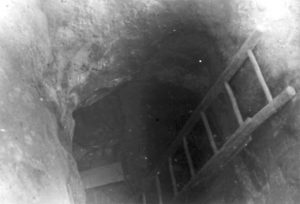
An entrance to a bunker, dug out by the Germans to flush out the Jews with fire.
1943 Jun 30 – German SS- und Polizeiführer Friedrich (Fritz) Katzmann congratulates himself and his staff for successfully making Distrikt Galizien “free from Jews” in a secret report he submits to his superior, Friedrich-Wilhelm Krüger. The report details Jewish resistance efforts which slowed and endangered the SS deportation and execution work, including a series of large defensive bunkers in Rohatyn, uncovered and burned during the liquidation of the Rohatyn ghetto earlier in the month. [14] Not all underground hiding places are excavated; the remains of some hidden Jews will be discovered almost 70 years later.
1943 summer ~1944 spring – Thirteen Jews hide in a cellar under the Rohatyn district administration center, which also served the Gestapo command. Aided by a Ukrainian man from the nearby village of Putiatyńce, nine of the Jews survive there in hunger and poor health, resurfacing when the Soviet army recaptures Rohatyn. [3, p.338~339] Elsewhere in town, two young Jewish women are sheltered and fed in the family house of the Ukrainian police commander, sleeping at night in the room of the family’s daughters. [16, p.109~124] Villagers who live outside of Rohatyn sometimes encounter Jewish families and individuals hiding in the forests and fields, occasionally in farm buildings near the villages. Most are starving; villagers give food to some Jews in secret, but any contact is dangerous for everyone while Germans still occupy the region. Many Jews in hiding are eventually caught, taken to the north mass grave, and shot. [12, witness YIU/2098U, 34:23~40:52]
1943 Dec 13 – German soldiers capture 24 local Ukrainian nationalists originally from near Berezhany and Ternopil; the resident German authority orders their public execution by firing squad against a wall of the Ukrainian church near the town square. Following the execution, the bodies are gathered and buried in a common grave. [12, witness YIU/2092U, 0:59:25]
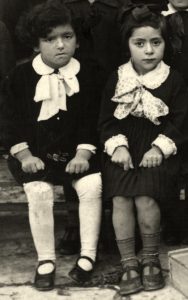
A 1937 Hebrew school class photo, showing Izio Horn’s cousin Malka Horn, and his sister (whose name is lost). [1, p.187]
1944 early Mar – While Kuba Glotzer is 2km away with another family, repairing a potato sack for carrying food, his cousin Josie Altman is murdered by uniformed Ukrainian Banderowce in Kuba’s hiding place with about 15 other Jews in the Łopuszna woods. Josie was 18 years old; his death leaves Kuba with no family in his fugitive group. [4, p.28]
1944 late April – The Soviet Army has pushed the German Army back to Tarnopol. [4, p.28] Armed Ukrainians assault the village of Łopuszna and kill Poles who had been feeding and sheltering Jews, including Kuba Glotzer. [4, p.29]
1944 Jun 27 – The German Luftwaffe photographs Rohatyn from the air to record the roads, bridges, rail lines, and other strategic assets, as their Army retreats from east Galicia. The surviving images reveal the destruction to the former Jewish ghetto area in town, among other burned areas.
1944 Jul 06 – Advancing rapidly from Tarnopol, the Soviet Army liberates the village of Łopuszna. [4, p.30] However, there are rumors that Rohatyn is still occupied by Germans, and the surviving Jews cannot return to their prewar home. The Soviet soldiers are almost as hungry and exhausted as the Jews, so cannot provide much aid. Kuba and a few others move to Brzeżany, recently liberated, and stay there for a few weeks. [4, p.30]
1944 early Jul – Kuba Glotzer’s brother Samuel and his cousin Clara are betrayed in the hiding place near Rohatyn where they had moved after staying with the Polish family in Babińce; they are killed by the German Army two weeks before the liberation. Kuba now has no immediate family in Europe; his ailing father is still in America. [4, p.31]
1944 Jul 24 – The Soviet Army liberates Rohatyn. Less than a hundred Jews from the area survive, from an original population of about three thousand in Rohatyn and several thousand more from the surrounding towns and villages. [2]
1944 late Jul – Kuba Glotzer is drafted into the Soviet Army. He is sent westward through Poland for training until January 1945, then advances with the Army to the then-existing German border. In intense fighting in Silesia, an exploding shell wounds Kuba in the hand; he is treated locally, then shipped to Katowice, Lwów, and eventually Rohatyn for additional care. [4, p.33]1944 Dec 20 – The Soviet Extraordinary State Commission files an investigation report documenting material losses in Rohatyn due to actions of the Nazi occupation there. In tabulated rows counting the losses of buildings, gardens, and livestock, the report assigns those losses to Rohatyn families, lists the sizes of the families, and records the wartime fate of the families. The report lists Ukrainian, Polish, and Jewish family names, but the list is dominated by Jews. Nearly every Rohatyn Jewish family in the list is recorded as “shot” or “all killed”: Of the 15 recorded Glotzer family members, only 3 survive; of 12 Barbans, only one; of 30 Horns, none survive. [20]
1945 Apr 14 – Writing from Jerusalem, where she had been living since she emigrated to Palestine in 1936, Bronia Horn writes an anxious letter to America asking the friend who had helped her emigrate if he had any news of her family in Rohatyn – including her brothers David and Jonas Horn: “All of us are upset, unhappy, and worn out about our families in Poland, and still hoping for miracles.” [23]
1945 May 8~9 – The war in Europe ends with the unconditional German Instrument of Surrender.
Kuba Glotzer was recalled to his Soviet Army division following the end of the war, and served with other Jewish survivors in the Army as an agricultural worker, a POW guard, and an ordinary soldier in western Ukraine until his discharge in March 1946. He returned to Rohatyn for two months, then passed through Poland to Germany, and for the next three years lived in displaced persons (DP) camps in Germany before emigrating to America. He returned to Rohatyn fifty years later with his wife, for the dedication of the mass grave and cemetery memorials in 1998. [4, p.33~39]
Related Articles on this Website:
The Jewish Population of Rohatyn
The Katzmann Report and Rohatyn
Rohatyn in the Oneg Shabbat – Ringelblum Archive
USHMM Encyclopedia: Ghettos of Rohatyn and the Region
Rohatyn’s Wartime Righteous Gentiles
Yahad – In Unum Interviews with Rohatyn Holocaust Witnesses
Sources:
[1] Yizkor Book for Rohatyn: The Community of Rohatyn and Environs (Kehilat Rohatyn v’hasviva); eds. M. Amihai, David Stockfish, and Shmuel Bari; Rohatyn Association of Israel, 1962 (in Hebrew). Online image version hosted by the New York Public Library. Online English version hosted by JewishGen, coordinated by Michael J. Bohnen and Donia Gold Schwarzstein. Includes a partial list of the names of murdered Jews of Rohatyn and surrounding communities. [2] Encyclopedia of the Jewish Communities of Poland (Pinkas ha-kehillot Polin), Volume II (Eastern Galicia); eds. Danuta Dabrowska, Abraham Wein, Aharon Weiss; by Zvi Avital, Danuta Dabrowska, Abraham Wein, Aharon Weiss, Aharon Jakubowicz; Yad Vashem, Jerusalem 1980 (in Hebrew). Online English version hosted by JewishGen. Pages 506~510 on Rohatyn coordinated by Alex Feller, English translation by Ruth Yoseffa Erez. [3] Remembering Rohatyn and Its Environs; Donia Gold Shwarzstein, editor; Meyer Shwarzstein, publisher; 2019. [4] I Survived the German Holocaust Against All Odds; Jack Glotzer; 2nd Edition; Creative Commons; 2018. [5] Third decree concerning limitations of residency in the General Government; Verordnungsblatt für das Generalgouvernement; Warsaw, 15Oct1941; in Polacy-Żydzi 1939~1945, Selection of Documents; Andrzej Krzysztof Kunert, ed.; Muzeum Historii Polski; Warszawa 2006. [6] Hundreds of Towns in Poland Made “Judenrein,” Nazi Government Reports; JTA Daily News Bulletin; Volume IX, No. 296; Jewish Telegraph Agency; New York, 24Dec1942. [7] Рогатинське слово (Rohatyn Word); periodical (mostly weekly) in Ukrainian language published in Rohatyn under German occupation; 23Jul1941~03Dec1941; sourced from Libraria Ukrainian Online Periodicals Archive. [8] A History of Ukraine: The Land and Its Peoples; Paul Robert Magocsi; University of Toronto Press; 2nd Edition, Toronto, 2010. [9] Case No. 634, Other Mass Extermination Crimes; Justiz und NS-Verbrechen: Nazi Crimes on Trial. [10] Case No. 675, Other Mass Extermination Crimes; Justiz und NS-Verbrechen: Nazi Crimes on Trial. [11] Metropolitan Andrey Sheptytsky and the Holocaust; John-Paul Himka; in Jews and Ukrainians; Polin Studies in Polish Jewry Volume 26; Yohanan Petrovsky-Shtern and Antony Polonsky, eds.; The Littman Library of Jewish Civilization; Portland, 2014. [12] Yahad – In Unum interviews with Rohatyn Holocaust witnesses, 2016. [13] Encyclopedia of Camps and Ghettos, 1933–1945; Vol. II: Ghettos in German-Occupied Eastern Europe; Martin Dean and Mel Hecker, eds.; United States Holocaust Memorial Museum and Indiana University Press; Bloomington, 2012. Rohatyn appears on p.821~822. [14] Nazi Conspiracy and Aggression, Volume VII; Office of United States Chief Counsel for Prosecution of Axis Criminality; U.S. Department of State, U.S. War office, and International Military Trials – Nürnberg; U.S. Government Printing Office, 1946. Sourced from U.S. Library of Congress. The official English translation of the report from the IMT trials. See also The Katzmann Report and Rohatyn on this website. [15] The Gates of Europe: A History of Ukraine; Serhii Plokhy; Penguin Books; 2015. [16] A Journey Through Grief – The Autobiography of a Holocaust Survivor; Rosette Faust Halpern; lulu.com; 2013. [17] Among Men and Beasts; Paul Trepman; translated from the Yiddish by Shoshana Perla and Gertrude Hirschler; A. S. Barnes and Co., Inc.; Cranbury, New Jersey, 1978. [18] Sheva’s Promise – Chronicle of Escape from a Nazi Ghetto; Sylvia Lederman; Syracuse University Press; New York, 2013. [19] The Mass Extermination of Jews in German Occupied Poland; Polish Ministry of Foreign Affairs; Hutchinson & Co. Ltd.; London, 1942. [20] State Archive of the Russian Federation (GARF); Extraordinary State Commission to Investigate German‐Fascist Crimes Committed on Soviet Territory from the USSR, 1941‐1945; record 7021‐73-13. Sourced by Yefim Kogan. Also USHMM RG‐22.002M; United States Holocaust Memorial Museum Archives; Washington, DC; microfilm reel 11, fond-opis 7021‐73 (Ukraine, Stanislavskaya oblast), delo 13 (Rogatinskiy raion). [21] Ukrainian State Archives of the Ivano-Frankivsk Oblast (DAIFO); fond 57, Nazi Labor Cards. Sourced by Alex Denysenko. [22] Central Database of Shoah Victims’ Names (search for Rohatyn recorded as place of death); Yad Vashem; ongoing; part of Yad Vashem’s Names Recovery Project. [23] Marla Raucher Osborn; personal interviews and correspondence with former Rohatyn resident Jacob Hornstein and his daughter Harriet Jerusha Korim. [24] Deutsche Herrschaft, ukrainischer Nationalismus, antijüdische Gewalt: Der Sommer 1941 in der Westukraine (German Rule, Ukrainian Nationalism, Anti-Jewish Violence: The Summer of 1941 in Western Ukraine); Kai Struve; Walter de Gruyter GmbH; Berlin, 2015. [25] Українське державотворення: Акт 30 червня 1941: Збірник документів і матеріалів (Ukrainian State-Building: The Act of 30 June 1941: Collected Documents and Materials); Orest Dziuban; “Pyramid” Literary Agency; Lviv, 2001. [26] Death Camp in Bełżec; Robert Kuwałek, translated by William Brand; Państwowe Muzeum na Majdanku; Lublin, 2016. Free pdf download in Ukrainian available on the website of the Ukrainian Center for Holocaust Studies.General References:
Bloodlands: Europe Between Hitler and Stalin; Timothy Snyder; Vintage; London, 2010.
Black Earth: The Holocaust as History and Warning; Timothy Snyder; Vintage; London, 2015.
Life in the Ghettos During the Holocaust; Eric J. Sterling, ed.; Syracuse University Press; Syracuse, 2005.
In Broad Daylight: The Secret Procedures Behind the Holocaust by Bullets; Father Patrick Desbois; Arcade Publishing; New York, 2018.
The Holocaust in Ukraine: New Sources and Perspectives; United States Holocaust Memorial Museum, Center for Advanced Holocaust Studies; conference proceedings, April 2013.
See also the general references on the history outline page.

